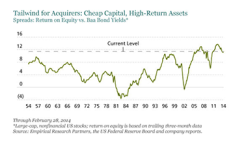There seems to be a new calculus at work in the recent rash of takeovers, as investors set aside their usual wariness of deals for the promise of growth these combinations may bring. We think it’s a good reason to stick with stocks.
Announced global deals this year have already hit $1 trillion as of the end of March, one of the highest quarterly levels since 1998 and almost double the level announced for the same period a year ago. The trend is reaching across industries and regional markets — with recent announcements including U.S. pharmaceutical company Pfizer’s $106 billion (and climbing) bid for U.K.-Swedish drugmaker AstraZeneca, the cable giant Comcast’s proposed $45.2 billion acquisition of Time Warner Cable and the pending $35 billion merger between global advertising giants Omnicom and Publicis.
The recent wave of M&A mania is no shock. It’s been expected for some time. The market’s response, however, has been a surprise. More often than not, the stocks of both the acquirer and acquired rally on the news of a combination, friendly or otherwise. But this reaction contrasts with the historical pattern. From the early 1990s until the past couple of years, stock market returns for the top quintile of the most acquisitive U.S. companies have trailed the market by about 9 percentage points annualized. History is rife with acquisitions gone wrong. For example, the management teams involved overpay or overestimate the potential value of any synergies coming out of the deal.
Over the past couple of years, however, returns for the most acquisitive quintile of companies have outperformed the market by almost 15 percentage points annualized. Why the big reversal? Are deal-making managements suddenly geniuses and careful stewards of capital? Or is something else going on?
By our reading, much of this atypical behavior is a reaction to the atypically favorable conditions for accretive deals. For one thing, the bar for evaluating acquisitions has never been lower. The balance sheets of both acquirers and their targets are flush with cash, whereas the opportunity cost of capital — as measured by the return that companies get on cash — is next to nothing. Likewise, the aftertax cost of debt is very low, owing to historically low interest rates and tight corporate credit spreads.
Moreover, the prospective targets of this cheap capital are of unusually high quality. The present yield on Baa-rated U.S. corporate bonds is about 5 percent — whereas return on equity for large-cap U.S. stocks is nearly 17 percent. That translates to a spread of more than 11 percentage points, nearly double the average spread of the past six decades (see chart 1). That’s a powerful tailwind for acquirers.

For cash-rich U.S. multinationals, tax savings can be another major enticement. Instead of repatriating its hoard of cash overseas — subjecting it to higher U.S. taxes — Pfizer is proposing to use that cash to finance its takeover of AstraZeneca and reincorporate the new, combined company in the U.K., where the lower corporate tax rate and other potential breaks could save Pfizer $1 billion or more annually. Since 2008 about two dozen U.S. companies have used this strategy to shift to a legal residence abroad via acquisition.
The main concern of the stock market is growth. By our calculations, stocks are pricing in far less earnings growth than the 6 percent long-term average, whereas the share of market valuation accounted for by future growth remains well below average (see chart 2).

In our view, these factors are precisely why M&A activity is being so rewarded today. It reduces the uncertainty as to how surplus capital will get put to work and, with the cost of capital so low, raises the odds that acquisitions can boost future earnings growth.
It all works because the spread between the cost of debt and the return for investing in equity is so wide. Company managements will find ways to close that gap if the market does not do it for them. And with the equity risk premium (the extra compensation earned for investing in stocks relative to bonds) still well above the long-term average, we think stocks — particularly undervalued stocks — remain the best bet for investors.
Joseph G. Paul is chief investment officer of U.S. value equities at AllianceBernstein in New York.
See AllianceBernstein’s disclaimer.
Get more about equities.






